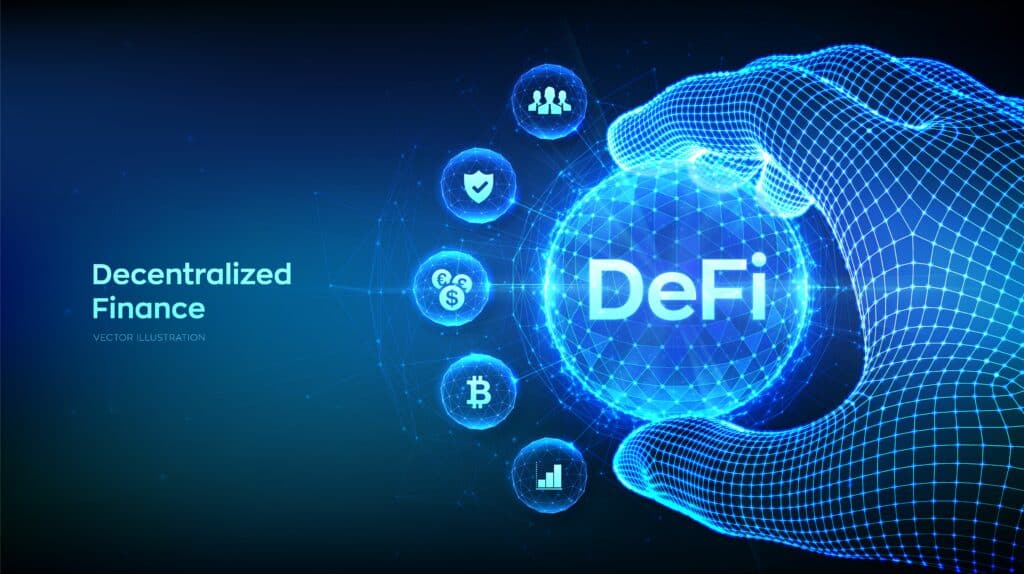Understanding DeFi: A Comprehensive Guide to Decentralized Finance – Top 2023

Decentralized Finance, known as DeFi, is revolutionizing the financial landscape. By leveraging blockchain technology, DeFi is transforming traditional financial systems and paving the way for a more transparent, accessible, and inclusive financial future. But what exactly is DeFi? Let’s delve into the details.
Introduction to Decentralized Finance (DeFi)
Decentralized finance, or DeFi, is a novel financial structure that leverages blockchain technology to disintermediate traditional financial intermediaries. DeFi aims to democratize finance by replacing centralized, legacy systems with peer-to-peer networks that offer a full spectrum of financial services.
In traditional finance, banks and other financial institutions act as intermediaries managing transactions, lending, asset trading, and more. These centralized entities control and offer services based on a set of rules defined by regulatory bodies like the Federal Reserve and Securities and Exchange Commission (SEC). However, DeFi challenges this centralized system and allows individuals to interact directly through digital exchanges, removing the need for intermediaries.
The Role of Blockchain in DeFi
Blockchain serves as the fundamental infrastructure for DeFi, allowing the creation of decentralized applications (dApps) and protocols. Blockchain platforms like Ethereum offer an environment for creating smart contracts—self-executing contracts with the terms of the agreement directly written into lines of code. These smart contracts enable the creation of complex financial use cases, extending beyond simple transactions.
Blockchain’s decentralized nature eliminates the need for a central authority in financial transactions. Instead, transactions are verified and recorded by network participants, enhancing transparency and reducing the risk of fraud. This decentralization also increases accessibility, as anyone with an internet connection can participate in DeFi, regardless of location or income level.
Stablecoins: The Foundation of DeFi
A critical component in the DeFi ecosystem is stablecoins. Stablecoins are cryptocurrencies pegged to stable assets, such as the U.S. dollar, aiming to minimize price volatility. Given the volatile nature of most cryptocurrencies, stablecoins provide a reliable medium of exchange within the DeFi space.
DAI is a prime example of a decentralized stablecoin widely used in DeFi. Unlike traditional stablecoins pegged to currency reserves, DAI is backed by over-collateralized crypto assets and its value is maintained through smart contracts. This decentralization makes DAI immune to censorship and a perfect candidate for DeFi applications.
Decentralized Finance Services and Applications
With a stable form of currency in place, the DeFi ecosystem can support a wide array of financial services and applications. These include:
Decentralized Exchanges (DEXs)
Decentralized exchanges, or DEXs, allow users to trade cryptocurrencies directly with each other, bypassing intermediaries. DEXs operate on blockchain-based smart contracts, automatically executing trades and securely handling funds. They provide round-the-clock service, are not confined by geographic boundaries, and do not require identity verification for participation.
Lending Platforms
Lending platforms connect borrowers and lenders directly, facilitating loans without the need for a traditional bank or financial institution. These platforms use smart contracts to enforce loan terms, distribute interest, and manage collateral, offering an alternative means of earning interest on cryptocurrency holdings.
Insurance Services
Decentralized insurance platforms connect individuals willing to buy insurance with those willing to underwrite it. This eliminates the need for an insurance company or broker, lowering costs and increasing efficiency.
Prediction Markets
Prediction markets allow users to bet on the outcome of future events, from elections to market trends. These markets operate on a peer-to-peer basis, leveraging blockchain technology for secure and transparent transactions.
Yield Farming and Liquidity Mining
Yield farming and liquidity mining are advanced financial strategies that involve lending cryptocurrency or providing liquidity to a protocol in exchange for interest or rewards. These strategies, while potentially lucrative, involve a higher degree of risk and complexity.
The Interoperability of Decentralized Finance
One of the most exciting aspects of DeFi is its composability, often referred to as “money legos.” The open-source nature of DeFi applications allows them to be combined and reconfigured to create new financial products and services. This interoperability enables a high degree of innovation and flexibility within the DeFi space.
Advantages and Potential Risks of DeFi
DeFi presents numerous advantages, including transparency, accessibility, interoperability, and the potential for high returns. However, it also carries inherent risks. As a nascent industry, DeFi is subject to volatility, smart contract vulnerabilities, and regulatory uncertainty. Before engaging with DeFi, it’s essential to understand these risks and exercise due diligence.
Conclusion
In conclusion, DeFi represents a paradigm shift in the world of finance, harnessing the power of blockchain technology to create a more decentralized, transparent, and inclusive financial system. As the DeFi landscape continues to evolve, it’s crucial to stay informed and understand the potential risks and rewards. In the end, DeFi could reshape our financial system and redefine how we interact with money.




